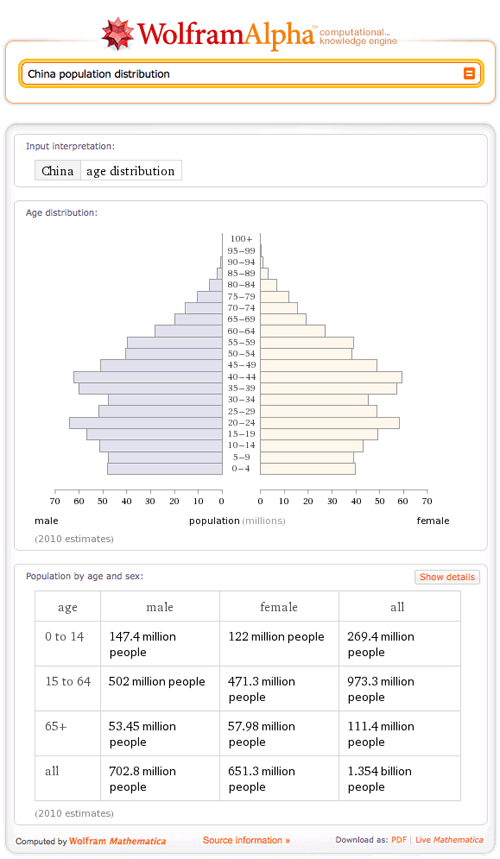By popular demand, Wolfram|Alpha recently expanded population data for most of the world’s countries, based in part on statistics from the United Nations Population Division. Populations are shaped by factors such as disease, war, genocide, and famine as well as more benign phenomena such as immigration. One of the more common user requests in this area has been to support queries like “China population distribution”, which now returns an age pyramid and detailed table of population by age and sex:
You can also query for specific age groups, as indicated on the pyramid, or just query for a single age, and Wolfram|Alpha will return data for the appropriate five-year age “bin”:

Here, Wolfram|Alpha computes that this age group represented about 6.5% of the total population in 2010. If you click the “Show history” button in the population fraction pod, you’ll also see that this fraction has been mostly in decline since 1950. What might China look like 20 years from now? Enter “China age distribution 2030” and you’ll see that, relative to the middle-aged, the youngest population is likely to represent an even smaller fraction of total population.
You can also compare multiple countries: try “US, China, India population fraction age 65 in 2030” to see how rapidly these countries are aging.
There is a lot of history to explore. Let us know if you spot any other interesting trends in this data.
Can’t wait to see the Manipulate version! One can see the changing of shapes of age distribution.
Quite interesting, I say this is a good step for W|A into social studies for which, by the way, immigration is rather regarded as a social phenomena not always benign. Congratulations!
Looks to be very interesting indeed. Can’t wait for a “Manipulate” funktion 🙂
18-years-old or older is useful as this is the segment of the population that can register to vote in elections. Any way to calculate this using this new functionality?
Hello Gustavo, That computation is not available at this time. It is a nice idea and we’ve shared it with our development team. Thank you!



 Comments Off
Comments Off

